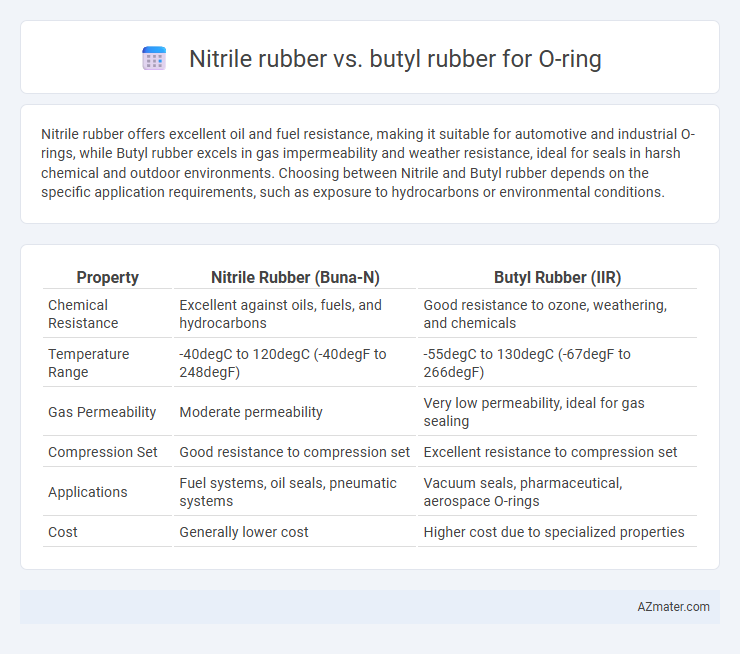Nitrile rubber offers excellent oil and fuel resistance, making it suitable for automotive and industrial O-rings, while Butyl rubber excels in gas impermeability and weather resistance, ideal for seals in harsh chemical and outdoor environments. Choosing between Nitrile and Butyl rubber depends on the specific application requirements, such as exposure to hydrocarbons or environmental conditions.
Table of Comparison
| Property | Nitrile Rubber (Buna-N) | Butyl Rubber (IIR) |
|---|---|---|
| Chemical Resistance | Excellent against oils, fuels, and hydrocarbons | Good resistance to ozone, weathering, and chemicals |
| Temperature Range | -40degC to 120degC (-40degF to 248degF) | -55degC to 130degC (-67degF to 266degF) |
| Gas Permeability | Moderate permeability | Very low permeability, ideal for gas sealing |
| Compression Set | Good resistance to compression set | Excellent resistance to compression set |
| Applications | Fuel systems, oil seals, pneumatic systems | Vacuum seals, pharmaceutical, aerospace O-rings |
| Cost | Generally lower cost | Higher cost due to specialized properties |
Introduction to Nitrile and Butyl Rubber O-Rings
Nitrile rubber O-rings offer excellent resistance to petroleum-based oils, fuels, and chemicals, making them ideal for automotive and industrial applications. Butyl rubber O-rings provide superior impermeability to gases and excellent resistance to heat, ozone, and weathering, suitable for sealing applications in harsh environments. Both materials serve as essential sealing solutions, with nitrile favored for oil resistance and butyl for excellent impermeability and environmental durability.
Key Material Properties: Nitrile Rubber
Nitrile rubber (NBR) offers excellent resistance to petroleum-based oils, fuels, and other chemicals, making it a preferred choice for O-rings in automotive and industrial applications. Its superior tensile strength and good abrasion resistance enhance durability under dynamic conditions. The material also maintains flexibility and sealing performance across a temperature range of approximately -40degC to 120degC, ensuring reliable operation in moderate temperature environments.
Key Material Properties: Butyl Rubber
Butyl rubber offers exceptional resistance to gases, excellent impermeability, and superior flex resistance compared to nitrile rubber, making it ideal for O-rings in applications involving air and moisture sealing. Its outstanding chemical stability and low permeability to gases enhance durability in harsh environments, including exposure to acidic and alkaline substances. Although it has lower tensile strength and abrasion resistance than nitrile rubber, butyl rubber's cold temperature flexibility and non-reactivity with oxygen and ozone make it a preferred choice for O-ring seals in automotive, pharmaceutical, and industrial settings.
Chemical Resistance Comparison
Nitrile rubber offers excellent resistance to petroleum-based oils, fuels, and many hydraulic fluids, making it ideal for applications involving hydrocarbons. Butyl rubber exhibits superior resistance to polar solvents, ozone, weathering, and a broad range of chemicals, including ketones and esters, which nitrile rubber generally cannot withstand. Selecting between nitrile and butyl rubber O-rings depends on the specific chemical environment, with butyl rubber preferred for aggressive chemicals and nitrile for oil-based exposures.
Temperature Resistance: Nitrile vs. Butyl
Nitrile rubber (NBR) offers temperature resistance typically ranging from -40degC to 120degC, making it suitable for applications involving moderate heat exposure. Butyl rubber (IIR) withstands a broader temperature range, from -50degC up to 150degC, providing enhanced performance in extreme temperature conditions. For O-rings requiring higher heat tolerance and flexibility at low temperatures, butyl rubber is often preferred over nitrile rubber.
Ozone and Weathering Performance
Nitrile rubber offers moderate ozone resistance but tends to degrade faster under prolonged weathering conditions, making it less suitable for outdoor applications exposed to harsh environments. Butyl rubber excels in ozone and weathering performance due to its excellent impermeability and high resilience against ozone-induced cracks, ensuring longer-lasting O-rings in outdoor and industrial settings. Choosing butyl rubber for O-rings enhances durability and reliability where exposure to ozone and environmental factors is critical.
Compression Set and Seal Longevity
Nitrile rubber (NBR) offers excellent resistance to oils and fuels with a moderate compression set, typically around 25-40%, which affects the seal's ability to maintain its shape under continuous compression and ultimately its longevity. Butyl rubber (IIR) demonstrates a much lower compression set, often below 20%, enabling superior seal recovery and longer-lasting performance, especially in applications involving heat and ozone exposure. For critical O-ring applications requiring consistent sealing and extended service life, butyl rubber generally outperforms nitrile rubber in terms of compression set and seal durability.
Ideal Applications for Nitrile O-Rings
Nitrile rubber O-rings excel in applications requiring excellent resistance to petroleum-based oils, fuels, and hydraulic fluids, making them ideal for automotive, aerospace, and industrial machinery seals. Their high tensile strength and wear resistance suit dynamic sealing situations with temperatures ranging from -40degC to 120degC. Nitrile O-rings also provide superior abrasion resistance and compatibility with water-based fluids, outperforming butyl rubber in oil exposure scenarios.
Ideal Applications for Butyl O-Rings
Butyl rubber O-rings excel in applications requiring exceptional resistance to gases, moisture, and extreme temperatures, making them ideal for sealing in pharmaceutical, food, and chemical processing industries. Their superior impermeability and resistance to ozone, weathering, and aging also make them suitable for automotive and HVAC systems where long-term durability is critical. Unlike nitrile rubber, butyl rubber demonstrates excellent performance in acidic and caustic environments, ensuring reliable sealing in aggressive chemical applications.
Choosing the Right Material for Your O-Ring Needs
Nitrile rubber (NBR) offers excellent resistance to oils, fuels, and high abrasion, making it ideal for automotive and industrial O-rings exposed to petroleum-based fluids. Butyl rubber (IIR) excels in chemical resistance to acids, alkalis, and ozone, along with superior impermeability to gases, suitable for sealing gases and harsh chemicals in medical and aerospace O-rings. Selecting the right O-ring material depends on environmental exposure, temperature range, and fluid compatibility to ensure durability and optimal sealing performance.

Infographic: Nitrile rubber vs Butyl rubber for O-ring
 azmater.com
azmater.com